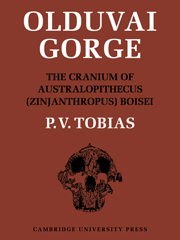Book contents
- Frontmatter
- Contents
- List of text-figures
- List of plates
- List of tables
- Introductory Note
- Foreword
- Editor's Note
- Acknowledgements
- I Introduction
- II Preservation and reconstruction of the cranium
- III The cranial vault
- IV The basis cranii externa
- V Certain critical angles and indices of the cranium
- VI The interior of the calvaria
- VII The thickness of the cranial bones
- VIII The endocranial cast of Zinjanthropus
- IX Metrical characters of the calvaria as a whole
- X The structure of the face
- XI The pneumatisation of the Zinjanthropus cranium
- XII The dental arcade and the palate
- XIII The pattern of dental attrition and occlusion, with comments on enamel hypoplasia
- XIV The size of individual teeth, absolute and relative
- XV The size of the dentition as a whole
- XVI The crown shape index of the teeth
- XVII The morphology of the teeth
- XVIII Summary of cranial and dental features of Zinjanthropus
- XIX The taxonomic status of Zinjanthropus and of the australopithecines in general
- XX The cultural and phylogenetic status of Australopithecus boisei and of the australopithecines in general
- References
- Index of persons
- Index of subjects
- Plate section
II - Preservation and reconstruction of the cranium
Published online by Cambridge University Press: 05 November 2011
- Frontmatter
- Contents
- List of text-figures
- List of plates
- List of tables
- Introductory Note
- Foreword
- Editor's Note
- Acknowledgements
- I Introduction
- II Preservation and reconstruction of the cranium
- III The cranial vault
- IV The basis cranii externa
- V Certain critical angles and indices of the cranium
- VI The interior of the calvaria
- VII The thickness of the cranial bones
- VIII The endocranial cast of Zinjanthropus
- IX Metrical characters of the calvaria as a whole
- X The structure of the face
- XI The pneumatisation of the Zinjanthropus cranium
- XII The dental arcade and the palate
- XIII The pattern of dental attrition and occlusion, with comments on enamel hypoplasia
- XIV The size of individual teeth, absolute and relative
- XV The size of the dentition as a whole
- XVI The crown shape index of the teeth
- XVII The morphology of the teeth
- XVIII Summary of cranial and dental features of Zinjanthropus
- XIX The taxonomic status of Zinjanthropus and of the australopithecines in general
- XX The cultural and phylogenetic status of Australopithecus boisei and of the australopithecines in general
- References
- Index of persons
- Index of subjects
- Plate section
Summary
The fossil remains, to which the name ‘Zinjanthropus boisel’ anthropus boisei' has been given, comprise an almost complete cranium with the entire maxillary dentition. In the same level of Bed I were found some fragments of a second cranium and parts of the shafts of a gracile hominid tibia and fibula, while from the slope just below were recovered an upper lateral incisor, an upper molar and a lower premolar of a very gracile dentition. According to Leakey, ‘the hominid skull was found as a single unit within the space of approximately one square foot by about six inches deep…The expansion and contraction of the bentonitic clay, upon which the skull rested and in which it was partly embedded, had resulted, over the years, in its breaking up into small fragments…’ (1959a, p. 491). However, despite its fragmentary condition, the individual pieces of bone are in a beautiful state of preservation: there is no sign of warping or squashing or other pressure effects, nor are the surfaces defaced by weathering. As a result, a wealth of anatomical detail is preserved in the cranium, which compares most favourably with the very best of the australopithecine remains hitherto described from South Africa. In completeness and state of preservation, the Zinjanthropus cranium must take its place alongside the child skull from Taung and the adult cranium (Sts 5) from Sterkfontein as the most perfect of the early hominid crania thus far found in Africa.
Information
- Type
- Chapter
- Information
- Olduvai Gorge , pp. 6 - 8Publisher: Cambridge University PressPrint publication year: 1967
